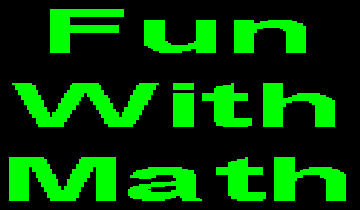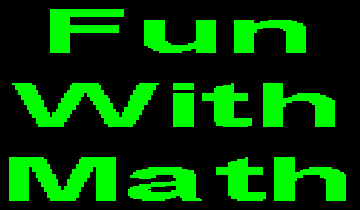 Home
DFS
SB
OD
SDN
Home
DFS
SB
OD
SDN
To get an understanding, let's take these basic rules of addition and multiplication:
a0 a0
+ b0 x b0
--- ---
c1c0 c1c0
Where a0 and b0 are single digit numbers, and
c1c0 can be a two-digit number.
In variable a0 is a one-digit number.
In variable b0 is a one-digit number.
In variable c0 is the ones portion of a two-digit number.
In variable c1 is the tens portion of a two-digit number.
Let a0 = 3 and b0 = 4
Add a0 and b0 and store the result in c0, which is 7 in this case
Since c0 is less than 10, then moving the tens digit to the c1 variable is not necessary.
Multiply a0 and b0 and store the result in c0, which is 12 in this case
Since c0 is greater than 9, you'll need to move the tens digit to the c1 variable.
To do that, assuming that c1 is already pre-initialized to zero,
Then, you take the number in c0, and divide it by 10, and leave off the decimal part, then
add the integer portion to c1 like this:
c1 = c1 + INT(c0 / 10) (if the "c" array are decimal numbers)
c1 = c1 + c0 \ 10 (if the "c" array are integer numbers)
To remove the tens portion of the number in c0,
you can use either method:
c0 = c0 MOD 10 (which gives the remainder of 2 in this case)
c0 = c0 - 10 * INT(c0 / 10)
c0 = c0 - 10 * (c0 \ 10)
So c1 = 1 and c0 = 2 for the multiplication problem.
a1a0 a1a0
+ b1b0 x b1b0
-------- --------
c3c2c1c0 c3c2c1c0
We're putting
the "8" in a1,
the "5" in a0,
the "4" in b1, and
the "7" in b0.The rules for adding two numbers go like this:
a1a0 8 5
+ b1b0 4 7
--------
c1c0 1 2 (c0 = a0 + b0, overflow digit from c0 goes to c1)
c2c1 1 3 (c1 = a1 + b1 + c1, overflow digit from c1 goes to c2)
========
c2c1c0 1 3 2 (bring down all the lowermost variables)
Doing the computerizd math in these steps:
(note that the c array is preinitialized to zero before you add)
c0 = c0 + a0 + b0 12 = 5 + 7 c1 = c1 + INT(c0 / 10) 1 = INT(12/10) c0 = c0 - 10 * INT(c0 / 10) 2 = 12 - 10*INT(12/10) c1 = c1 + a1 + b1 13 = 1 + 8 + 4 c2 = c2 + INT(c1 / 10) 1 = INT(11/10) c1 = c1 - 10 * INT(c1 / 10) 3 = 13 - 10*INT(13/10)Now lets change gears to Multiplication!
We're putting
the "8" in a1,
the "5" in a0,
the "4" in b1, and
the "7" in b0.
The example is for multiplication.
We're going to store the answer 3,995 in the array "c" in positions.
c3, c2, c1, and c0
The rules for multiplying two numbers go like this:
a1a0 8 5
* b1b0 4 7
--------
c1c0 3 5 (c0 = a0 x b0, overflow digit from c0 added to c1)
c2c1 5 9 (c1 = a1 x b0 + c1, overflow digit from c1 added to c2)
c2c1 5 29 (c1 = a0 x b1 + c1,
7 9 overflow from c1 added to c2)
c3c2 3 9 (c2 = a1 x b1 + c2, overflow digit from c2 added to c3)
=========
c3c2c1c0 3 9 9 5 (bring down all the lowermost variables)
Doing the computerizd math in these steps:
(note that the c array is preinitialized to zero before you add)
c0 = c0 + a0 x b0 35 = 0 + 5 x 7 c1 = c1 + INT(c0 / 10) 3 = 0 + INT(35/10) c0 = c0 - 10 * INT(c0 / 10) 5 = 35 - 10*INT(35/10) c1 = c1 + a1 x b0 59 = 3 + 8 x 7 c2 = c2 + INT(c1 / 10) 5 = 0 + INT(59/10) c1 = c1 - 10 * INT(c1 / 10) 9 = 59 - 10*INT(59/10) c1 = c1 + a0 x b1 29 = 9 + 5 x 4 c2 = c2 + INT(c1 / 10) 7 = 5 + INT(29/10) c1 = c1 - 10 * INT(c1 / 10) 9 = 29 - 10*INT(29/10) c2 = c2 + a1 x b1 39 = 7 + 8 x 4 c3 = c3 + INT(c2 / 10) 3 = 0 + INT(39/10) c2 = c2 - 10 * INT(c2 / 10) 9 = 39 - 10*INT(39/10)Doing math with two 3-digit numbers is noticibly harder:
a2a1a0
* b2b1b0
---------------
c1c0 (c0 = c0 + a0 x b0)
c2c1 (c1 = c1 + a1 x b0)
c3c2 (c2 = c2 + a2 x b0)
c2c1 (c1 = c1 + a0 x b1)
c3c2 (c2 = c2 + a1 x b1)
c4c3 (c3 = c3 + a2 x b1)
c3c2 (c2 = c2 + a0 x b2)
c4c3 (c3 = c3 + a1 x b2)
c5c4 (c4 = c4 + a2 x b2)
=============
c5c4c3c2c1c0
So we need to simplify the multiplication into a formula. We could multiply and add the numbers in each element in one part
and move the overflows to the next elements to the left. The addition formula would be much easier to program.
For the multiplication table:
Dimension a(100), b(100), c(10000) * you may want to use smaller or larger values of array sizes, but be sure that the sizes of arrays a() and b() multiply to the size of array c(). Select number a$ and b$ (we put these in string variables instead of numbers since the numbers can hold up to 8 or 16 significant digits. Break up the digits in a$ and b$ and place each of them into the array elements of a() and b(). The ones digit goes in element 0 for 100, the tens go element 1 for 101, the hundreds in element 2, 1000's in 3, and so forth. Suppose we can put this complicated thing into a simple loop formula. This is what abc x def looks like when coded straight: c0 = c0 + a0 x b0 c1 = c1 + a1 x b0 c2 = c2 + a2 x b0 c1 = c1 + a0 x b1 c2 = c2 + a1 x b1 c3 = c3 + a2 x b1 c2 = c2 + a0 x b2 c3 = c3 + a1 x b2 c4 = c4 + a2 x b2 In the first third of the program, the b() array stays the same while the other arays increments by one In the second third of the program, the b() array is one higher, and the other arrays increments by one, but where the c() array begins is one higher. In the third third, the b() array is up one more, the c() array begins another one higher. So, let's place the formula in a loop: FOR x = 0 to 2 FOR y = 0 to 2 c(x + y) = c(x + y) + a(x) * b(y) NEXT y NEXT x The length of a$ and b$ varies, so we need to include their provisions: FOR x = 0 to LEN(a$) FOR y = 0 to LEN(b$) c(x + y) = c(x + y) + a(y) * b(x) NEXT y NEXT x What about the overflow digits? c1 = c1 + INT(c0 / 10) c0 = c0 - 10 * INT(c0 / 10) c2 = c2 + INT(c1 / 10) c1 = c1 - 10 * INT(c1 / 10) c3 = c3 + INT(c2 / 10) c2 = c2 - 10 * INT(c2 / 10) Lets try this method. Bear in mind that we need to set the loop to run as many times as there are digits in a$ and b$ combined. CAUTION: Do not reinitialize the c() array to 0! For x = 0 to LEN(a$)+LEN(b$) c(x+1) = c(x+1) + INT(c(x) / 10) c(x) = c(x) - 10 * INT(c(x) / 10) NEXT xTo add two really big numbers together, we'll use this program:
For the addition loop, we go from this: c0 = a0 + b0 c1 = a1 + b1 To this: FOR x = 0 to LEN(a$) + LEN(b$) c(x) = a(x) + b(x) NEXT xLet's put the whole program together!
DIM a(100), b(100), c(10000) CLS DO a$ = "": b$ = "" PRINT "INPUT two whole numbers:"; : INPUT a$, b$ FOR x = 0 TO LEN(a$) + LEN(b$): a(x) = 0: b(x) = 0: NEXT x FOR x = 1 TO LEN(a$) a(x - 1) = VAL(MID$(a$, LEN(a$) - x + 1, 1)) NEXT x FOR x = 1 TO LEN(b$) b(x - 1) = VAL(MID$(b$, LEN(b$) - x + 1, 1)) NEXT x ' operation$ = "x" FOR x = 0 TO LEN(a$) + LEN(b$): c(x) = 0: NEXT x FOR x = 0 TO LEN(a$) - 1 FOR y = 0 TO LEN(b$) - 1 c(x + y) = c(x + y) + a(x) * b(y) NEXT y NEXT x FOR x = 0 TO LEN(a$) + LEN(b$) c(x + 1) = c(x + 1) + INT(c(x) / 10) c(x) = c(x) - 10 * INT(c(x) / 10) NEXT x c$ = "" FOR x = (LEN(a$) + LEN(b$)) TO 0 STEP -1 c$ = c$ + LTRIM$(STR$(c(x))) IF LEFT$(c$, 1) = "0" AND x > 0 THEN c$ = "" NEXT x PRINT a$; " x "; b$; " = "; c$ ' operation$ = "+" FOR x = 0 TO LEN(a$) + LEN(b$): c(x) = 0: NEXT x FOR x = 0 TO LEN(a$) + LEN(b$) c(x) = a(x) + b(x) NEXT x FOR x = 0 TO LEN(a$) + LEN(b$) c(x + 1) = c(x + 1) + INT(c(x) / 10) c(x) = c(x) - 10 * INT(c(x) / 10) NEXT x c$ = "" FOR x = LEN(a$) + LEN(b$) TO 0 STEP -1 c$ = c$ + LTRIM$(STR$(c(x))) IF LEFT$(c$, 1) = "0" AND x > 0 THEN c$ = "" NEXT x PRINT a$; " + "; b$; " = "; c$ LOOP
© 1995-2023. davesfunstuff.com. All Rights Reserved. Reproduction of any part of this website without expressed written consent is prohibited.



